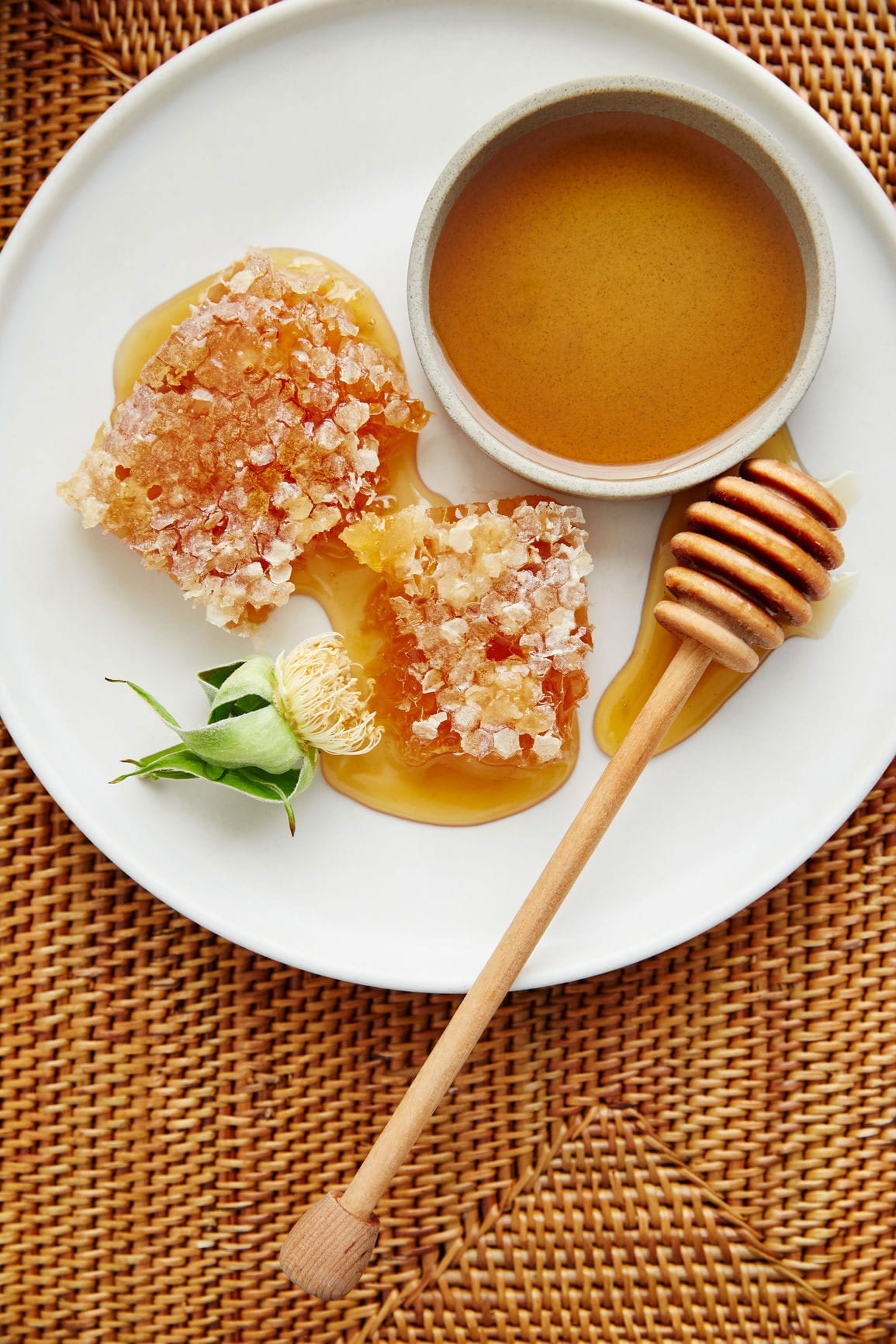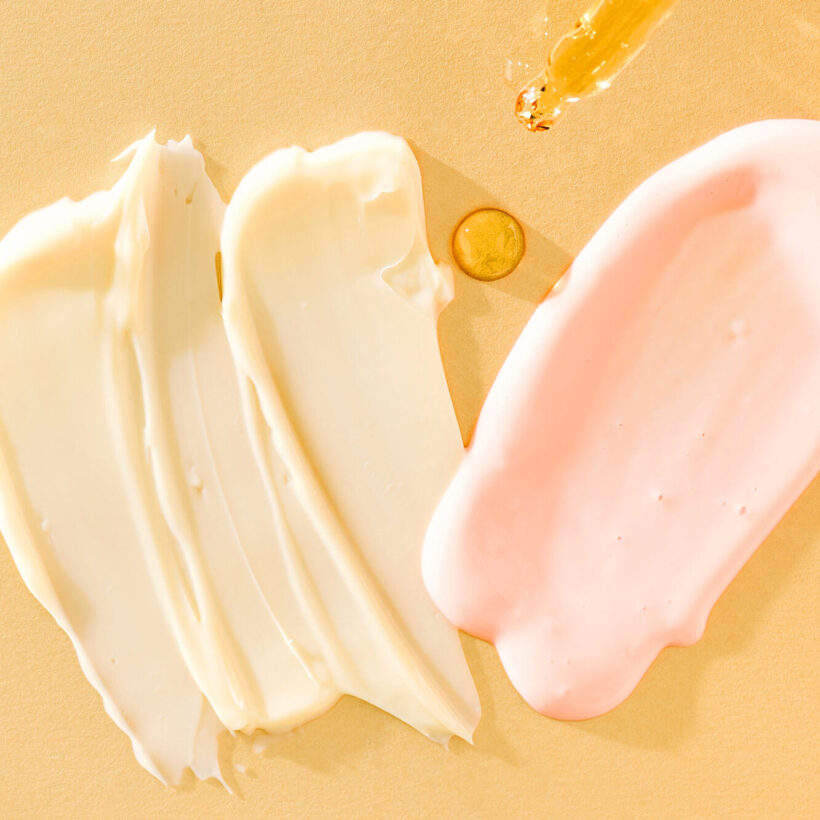Bee products like honey, pollen, propolis, royal jelly and even venom are having a major wellness moment. And, as with many promising ingredients, that moment has quickly turned into a skincare craze, too. While it might seem like this is a new phenomenon, incorporating bees into daily life — by way of healing, at least — has existed for thousands of years. So, why the sudden popularity?
Thanks to a current societal shift to more natural ingredients in personal wellness and beauty, science has been able to support the resurgence of bee products — such as the aforementioned pollen, propolis, royal jelly, venom and honey. “With modern science, we see a vast improvement in extraction techniques, leading to a more standardized and potent ingredient,” explains Mark Veeder, co-founder of Farmacy Skincare. As a result, the finished product is more successful and effective.
Find out how these ultra-effective bee-made products can up the ante in your daily beauty and wellness regimen.
Honey
Let’s start with the basics — aka, honey. While it might be one of the most well-known and widely-used bee products on the planet, there is a lot more to honey than meets the eye (or taste buds). According to Veeder, everyone should, at the very least, use pure, raw, unpasteurized honey in their daily routine for both its health and beauty benefits. “The key is to buy honey that has been extracted ethically by a beekeeper [not wild gathered honey], spun, and bottled using no heat, as heat kills many of the key nutrients in honey.” For safe measure, Veeder recommends shopping at your local farmer’s market so you can meet the beekeeper, know for sure where your honey came and ensure it is pure and has not been mixed with other sugary syrups.

As far as wellness benefits are concerned, honey is definitely that “spoonful of sugar” we can all use a bit more of. “Take a teaspoon of raw honey every morning to help strengthen your immune system,” Veeder recommends. In addition, honey has hydrogen peroxide properties, as it “contains an enzyme called glucose oxidase, which is secreted by the hypopharyngeal glands of bees.” This substance converts itself into hydrogen peroxide, making it a beneficial antiseptic.
With its astounding health benefits, it should come of no surprise that honey is one of the most beneficial beauty ingredients on the market. “Honey is a natural moisturizer and is full of antioxidants,” explains Debra Jaliman, M.D., a board-certified dermatologist in New York City. Considered a humectant — meaning it actually draws in moisture to the skin — honey can be very hydrating; therefore, it is one ingredient you do not want to skip if you have dry skin. In addition, the antioxidants found in honey can not only protect the skin from environmental aggressors but also help reverse some premature signs of aging like fine lines, wrinkles and dullness.
Since bees pollinate various plants, there are a variety of honey types available. Hawaiian White Honey (you can find it in Sunday Riley A+ High-Dose Retinoid Serum) has a much more mild taste than traditional dark honey, but it can offer a host of benefits. According to Dr. Alissia Zenhausern, NMD, a naturopathic physician at NMD Wellness of Scottsdale, Hawaiian White Honey is “an extreme antioxidant and also contains phytonutrients [aka, plant-sourced nutrients] that are necessary for healthy skin.” On top of that, “the antioxidant properties found in white honey also help with skin repair and wound healing.”
Another buzz-worthy honey is manuka. Derived from the manuka tree (native to New Zealand), manuka honey is most well-known for its healing properties and has even been used in hospitals to treat burns. “Although all raw, unheated kinds of honey are great for the skin, manuka has specifically been found to contain higher antioxidant properties,” notes Dr. Zenhausern. “Not only is manuka filled with antioxidants, but it contains anti-inflammatory properties that help reduce the appearance of acne,” she adds. And, since it is a natural humectant, “it also helps keep your skin hydrated.”
Royal Jelly
Royal jelly is a beneficial bee product and considered the holy grail of health and beauty. So powerful, it is “one of the only natural materials that science has never been able to fully replicate in the lab,” explains Veeder. On the wellness side of the spectrum, royal jelly contains 17 amino acids, eight of which “are essential ones that our body does not produce.” It also has beneficial sugar, fats and protein.
Beauty-wise, royal jelly is a must-try. “This jelly regulates skin photoaging after exposure to ultraviolet-B radiation,” explains Veeder. “It
You May Also Like
Propolis
Propolis, rich in vitamins, minerals and amino acids, is considered another “wonder” ingredient made by bees. And, much like the others, it too contains powerful healing benefits. “Made from the resin of trees combined with beeswax and bee secretion, propolis has antibacterial, antiviral, antifungal and anti-inflammatory properties,” notes Veeder. It has been used in medicine for so long that it was once a step in the ancient Egyptians’ embalming process.
According to Jaliman, propolis is also considered a natural antibiotic that “helps to prevent skin infections by inhibiting bacteria.
Pollen

Today, many health-focused recipes contain bee pollen as a topping — and for good reason. “Bee pollen is rich in vitamins, minerals, lipids, amino acids, enzymes, carotenoids and bioflavonoids,” says Alissia Zenhausern, N.M.D., a naturopathic physician at NMD Wellness of Scottsdale. But what exactly is bee pollen? According to Zenhausern, it occurs “when bees collect pollen from plants and mix it with a small amount of their saliva” and is produced only when the pollen is collected. Think of it as the halfway point between plant pollen and honey, as the more saliva bees add, the more it becomes like honey.
“The reason it is becoming so popular in skincare is that it not only provides the skin with essential nutrients, but it also contains antibacterial, antifungal and antiviral properties that help protect the skin,” says Zenhausern. Its wellness properties also reflect onto the skin. For example, “bee pollen helps reduce liver damage, which in turn will improve pigmentation,” notes Zenhausern. It is also high in antioxidants, which helps reduce oxidative stress inside out and, according to Jaliman, “contains rejuvenating nutrients which promote cellular regeneration.”
Venom
Albeit scary-sounding, bee venom can up the ante on your wellness and beauty regimen. “Bee venom has been used for many years in medicine to help with conditions including pain [associated with] rheumatoid arthritis and Multiple Sclerosis,” says Zenhausern. That said, because of so many allergies to bee stings (aka, venom), using bee venom treatments can be life-threatening, which is why Zenhausern stresses that all venom-related medical treatments should be done “in a safe medical facility with a doctor.”
In addition to its impressive pain reduction properties, bee venom is widely used in skincare and has been called natural Botox. “The way it works is that the main properties in bee venom known as Melittin is a protein that stimulates a slight inflammatory reaction to the skin which help increase blood circulation to the skin. This increase in blood circulation helps bring vital nutrients to the skin improving collagen and elastin in the skin, which keeps the skin tight and wrinkle-free,” explains Zenhausern. That said, it takes over 10,000 bee stings to make one gram of bee venom. So, while it might be powerful, it is also expensive to have these types of in-office treatments done. If you are hoping to reap the skin-tightening benefits of bee venom without a costly bill, look for products that contain traces of bee venom.
We only recommend products we have independently researched, tested and loved. If you purchase a product found through our links, Sunday Edit may earn an affiliate commission.










